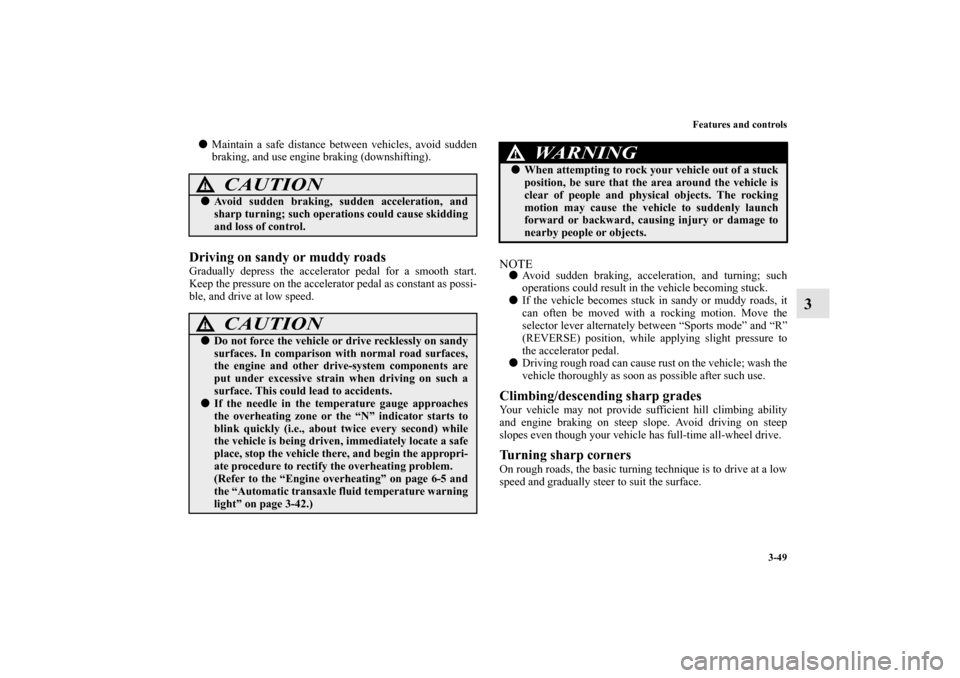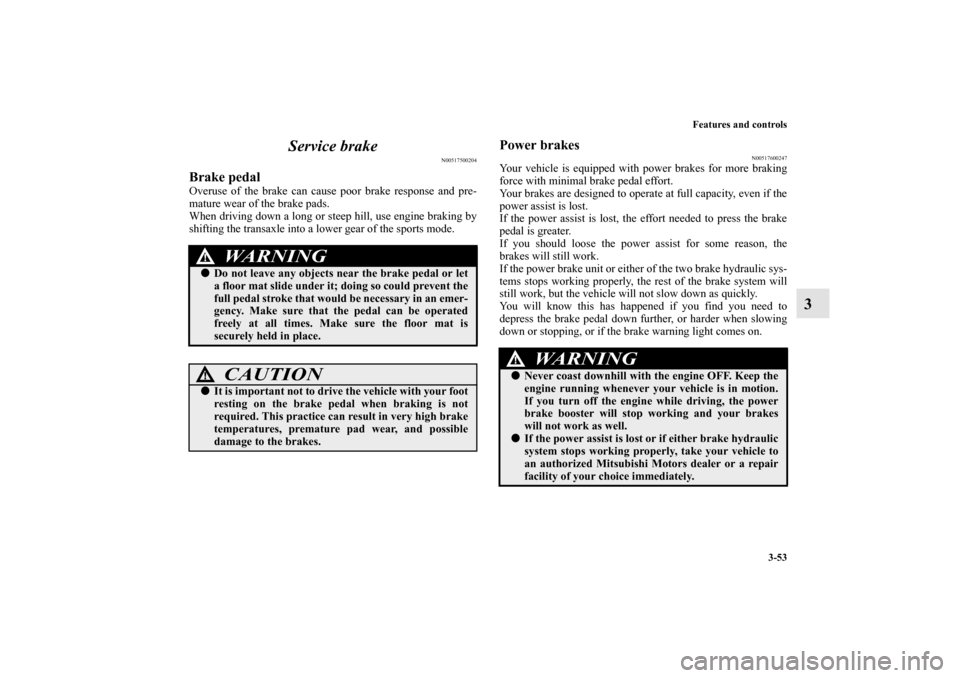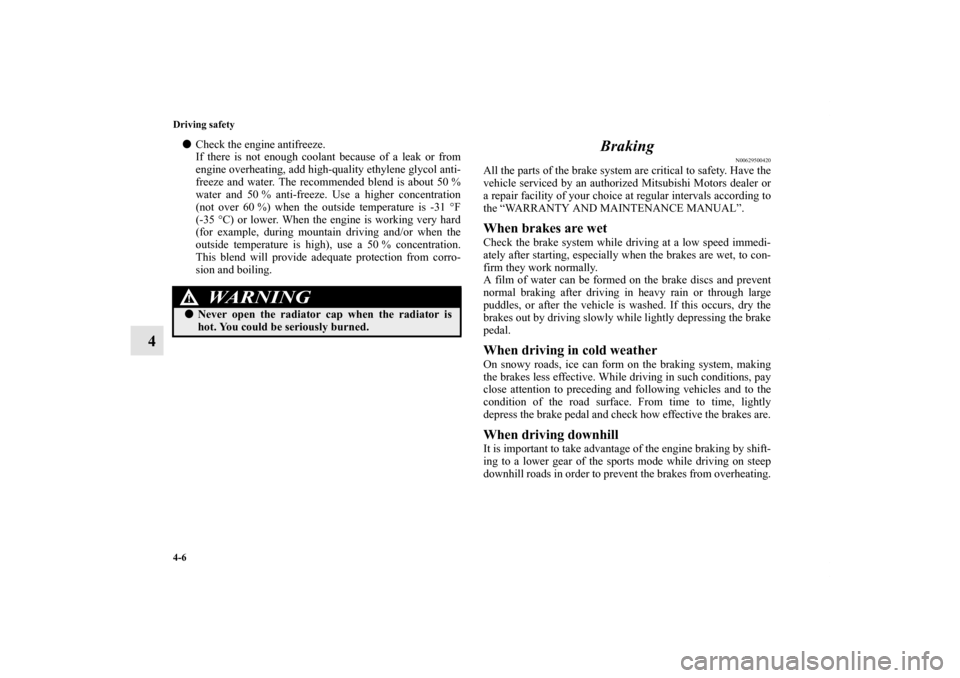Page 138 of 514

Features and controls
3-49
3
�Maintain a safe distance between vehicles, avoid sudden
braking, and use engine braking (downshifting).Driving on sandy or muddy roads Gradually depress the accelerator pedal for a smooth start.
Keep the pressure on the accelerator pedal as constant as possi-
ble, and drive at low speed.
NOTE�Avoid sudden braking, acceleration, and turning; such
operations could result in the vehicle becoming stuck.
�If the vehicle becomes stuck in sandy or muddy roads, it
can often be moved with a rocking motion. Move the
selector lever alternately between “Sports mode” and “R”
(REVERSE) position, while applying slight pressure to
the accelerator pedal.
�Driving rough road can cause rust on the vehicle; wash the
vehicle thoroughly as soon as possible after such use.Climbing/descending sharp gradesYour vehicle may not provide sufficient hill climbing ability
and engine braking on steep slope. Avoid driving on steep
slopes even though your vehicle has full-time all-wheel drive.Turning sharp cornersOn rough roads, the basic turning technique is to drive at a low
speed and gradually steer to suit the surface.
CAUTION
!�Avoid sudden braking, sudden acceleration, and
sharp turning; such operations could cause skidding
and loss of control.
CAUTION
!�Do not force the vehicle or drive recklessly on sandy
surfaces. In comparison with normal road surfaces,
the engine and other drive-system components are
put under excessive strain when driving on such a
surface. This could lead to accidents.�If the needle in the temperature gauge approaches
the overheating zone or the “N” indicator starts to
blink quickly (i.e., about twice every second) while
the vehicle is being driven, immediately locate a safe
place, stop the vehicle there, and begin the appropri-
ate procedure to rectify the overheating problem.
(Refer to the “Engine overheating” on page 6-5 and
the “Automatic transaxle fluid temperature warning
light” on page 3-42.)
WA R N I N G
!�When attempting to rock your vehicle out of a stuck
position, be sure that the area around the vehicle is
clear of people and physical objects. The rocking
motion may cause the vehicle to suddenly launch
forward or backward, causing injury or damage to
nearby people or objects.
BK0121600US.book 49 ページ 2010年4月12日 月曜日 午前10時39分
Page 142 of 514

Features and controls
3-53
3 Service brake
N00517500204
Brake pedalOveruse of the brake can cause poor brake response and pre-
mature wear of the brake pads.
When driving down a long or steep hill, use engine braking by
shifting the transaxle into a lower gear of the sports mode.
Power brakes
N00517600247
Your vehicle is equipped with power brakes for more braking
force with minimal brake pedal effort.
Your brakes are designed to operate at full capacity, even if the
power assist is lost.
If the power assist is lost, the effort needed to press the brake
pedal is greater.
If you should loose the power assist for some reason, the
brakes will still work.
If the power brake unit or either of the two brake hydraulic sys-
tems stops working properly, the rest of the brake system will
still work, but the vehicle will not slow down as quickly.
You will know this has happened if you find you need to
depress the brake pedal down further, or harder when slowing
down or stopping, or if the brake warning light comes on.
WA R N I N G
!�Do not leave any objects near the brake pedal or let
a floor mat slide under it; doing so could prevent the
full pedal stroke that would be necessary in an emer-
gency. Make sure that the pedal can be operated
freely at all times. Make sure the floor mat is
securely held in place.
CAUTION
!�It is important not to drive the vehicle with your foot
resting on the brake pedal when braking is not
required. This practice can result in very high brake
temperatures, premature pad wear, and possible
damage to the brakes.
WA R N I N G
!�Never coast downhill with the engine OFF. Keep the
engine running whenever your vehicle is in motion.
If you turn off the engine while driving, the power
brake booster will stop working and your brakes
will not work as well.�If the power assist is lost or if either brake hydraulic
system stops working properly, take your vehicle to
an authorized Mitsubishi Motors dealer or a repair
facility of your choice immediately.
BK0121600US.book 53 ページ 2010年4月12日 月曜日 午前10時39分
Page 305 of 514

4-6 Driving safety
4
�Check the engine antifreeze.
If there is not enough coolant because of a leak or from
engine overheating, add high-quality ethylene glycol anti-
freeze and water. The recommended blend is about 50 %
water and 50 % anti-freeze. Use a higher concentration
(not over 60 %) when the outside temperature is -31 °F
(-35 °C) or lower. When the engine is working very hard
(for example, during mountain driving and/or when the
outside temperature is high), use a 50 % concentration.
This blend will provide adequate protection from corro-
sion and boiling.
Braking
N00629500420
All the parts of the brake system are critical to safety. Have the
vehicle serviced by an authorized Mitsubishi Motors dealer or
a repair facility of your choice at regular intervals according to
the “WARRANTY AND MAINTENANCE MANUAL”.When brakes are wetCheck the brake system while driving at a low speed immedi-
ately after starting, especially when the brakes are wet, to con-
firm they work normally.
A film of water can be formed on the brake discs and prevent
normal braking after driving in heavy rain or through large
puddles, or after the vehicle is washed. If this occurs, dry the
brakes out by driving slowly while lightly depressing the brake
pedal.When driving in cold weatherOn snowy roads, ice can form on the braking system, making
the brakes less effective. While driving in such conditions, pay
close attention to preceding and following vehicles and to the
condition of the road surface. From time to time, lightly
depress the brake pedal and check how effective the brakes are.When driving downhillIt is important to take advantage of the engine braking by shift-
ing to a lower gear of the sports mode while driving on steep
downhill roads in order to prevent the brakes from overheating.
WA R N I N G
!�Never open the radiator cap when the radiator is
hot. You could be seriously burned.
BK0121600US.book 6 ページ 2010年4月12日 月曜日 午前10時39分